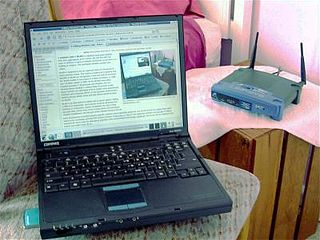
A wireless LAN (WLAN) is a wireless computer network that links two or more devices using wireless communication to form a local area network (LAN) within a limited area such as a home, school, computer laboratory, campus, office building etc. This gives users the ability to move around within the area and yet still be connected to the network. Through a gateway, a WLAN can also provide a connection to the wider Internet.
3G, short for third generation, is the third generation of wireless mobile telecommunications technology. It is the upgrade for 2G and 2.5G GPRS networks, for faster internet speed. This is based on a set of standards used for mobile devices and mobile telecommunications use services and networks that comply with the International Mobile Telecommunications-2000 (IMT-2000) specifications by the International Telecommunication Union. 3G finds application in wireless voice telephony, mobile Internet access, fixed wireless Internet access, video calls and mobile TV.
Cellco Partnership, doing business as Verizon Wireless, is an American telecommunications company which offers wireless products and services. It is a wholly owned subsidiary of Verizon Communications. Verizon Wireless is the largest wireless telecommunications provider in the United States.

WiMAX is a family of wireless broadband communication standards based on the IEEE 802.16 set of standards, which provide multiple physical layer (PHY) and Media Access Control (MAC) options.

A wireless mesh network (WMN) is a communications network made up of radio nodes organized in a mesh topology. It is also a form of wireless ad hoc network.

A hotspot is a physical location where people may obtain Internet access, typically using Wi-Fi technology, via a wireless local area network (WLAN) using a router connected to an internet service provider.

The history of mobile phones covers mobile communication devices that connect wirelessly to the public switched telephone network.
IEEE 802.11r-2008 or fast BSS transition (FT), also called fast roaming, is an amendment to the IEEE 802.11 standard to permit continuous connectivity aboard wireless devices in motion, with fast and secure handoffs from one base station to another managed in a seamless manner. It was published on July 15, 2008. IEEE 802.11r-2008 was rolled up into 802.11-2012.
A mobile phone operator, wireless provider, or carrier is a mobile telecommunications company that provides wireless Internet GSM services for mobile device users. The operator gives a SIM card to the customer who inserts it into the mobile device to gain access to the service.

Sierra Wireless is a multinational wireless communications equipment designer and manufacturer headquartered in Richmond, British Columbia, Canada. It also maintains offices and operations in California, France, Guangdong and Hong Kong.
A wireless ad hoc network (WANET) or MANET is a decentralised type of wireless network. The network is ad hoc because it does not rely on a pre-existing infrastructure, such as routers in wired networks or access points in managed (infrastructure) wireless networks. Instead, each node participates in routing by forwarding data for other nodes, so the determination of which nodes forward data is made dynamically on the basis of network connectivity and the routing algorithm in use.
In the Windows operating system, ad-hoc is a communication mode (setting) that allows computers to directly communicate with each other without a router.
Wireless mobile ad hoc networks are self-configuring, dynamic networks in which nodes are free to move. Wireless networks lack the complexities of infrastructure setup and administration, enabling devices to create and join networks "on the fly" – anywhere, anytime.
A wide variety of different wireless data technologies exist, some in direct competition with one another, others designed for specific applications. Wireless technologies can be evaluated by a variety of different metrics of which some are described in this entry.
Media Independent Handover (MIH) is a standard being developed by IEEE 802.21 to enable the handover of IP sessions from one layer 2 access technology to another, to achieve mobility of end user devices(MIH).
A mobile ad hoc network (MANET), also known as wireless ad hoc network or ad hoc wireless network, is a continuously self-configuring, infrastructure-less network of mobile devices connected wirelessly.
IEEE 802.11s is Wireless LAN standard and an IEEE 802.11 amendment for mesh networking, defining how wireless devices can interconnect to create a WLAN mesh network, which may be used for relatively fixed topologies and wireless ad hoc networks. The IEEE 802.11s working group draws upon volunteers from university and industry to provide specifications and possible design solutions for wireless mesh networking. As a standard, the document was iterated and revised many times prior to finalization.

Qi is an open interface standard that defines wireless power transfer using inductive charging over distances of up to 4 cm, and is developed by the Wireless Power Consortium. The system uses a charging pad and a compatible device, which is placed on top of the pad, charging via resonant inductive coupling.
Device-to-Device (D2D) communication in cellular networks is defined as direct communication between two mobile users without traversing the Base Station (BS) or core network. D2D communication is generally non-transparent to the cellular network and it can occur on the cellular frequencies or unlicensed spectrum.







